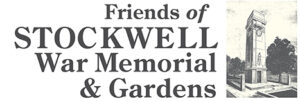Chris Burge writes:
E.G. Cox
Rifleman, London Regiment (London Irish Rifles), ‘B’ Coy.
Service no. 590198
Died in hospital in the UK on 18 February 1919, aged 22
Remembered at West Norwood Cemetery and Crematorium
Edward George Cox was born on 10 May 1896 and baptised at Holy Trinity (demolished in 1953), Vauxhall Bridge Road in Pimlico on the north side of the Thames, on 7 June 1896 when his parents Edward Charles and Harriet Cox were living at 32 Ponsonby Terrace in Pimlico. Edward’s father worked as a moulder in a brass foundry. Four years later, when Edward’s sister Mabel Johanna was born the family lived at 30 Garden Street [where?]. At the time of the 1901 census, the Cox family were living in two rooms at 54 Romney Buildings in Erasmus Street, just behind the Tate Gallery (now Tate Britain).
At the age of five, in 1902, Edward George Cox attended the newly-opened Millbank School, across the street from the Romney Buildings. The school, and Edward’s early home, were part of the Millbank Estate, an ambitious housing scheme built between 1897 and 1902 by the London County Council. Two years later, when their third child, Ivy Georgina, was born, the Cox family had moved again, to 11 Hunter Buildings on the recently built London County Council Borough Road Estate.
By 1911, Edward and family were living in more suburban surroundings at 5 Hill Street, Peckham, near the corner with Bird in Bush Road and close to the Surrey Canal. The Cox household then consisted of: Edward Charles, 40, and Harriett, 44; Edward George, 14; Mabel Johanna, 10; and Ivy Georgina, seven. In 16 years of marriage, Edward’s mother had borne four children, of whom three had survived. Edward had followed his father and now worked in a brass foundry. The Cox family lived in four rooms, the fifth room being occupied by Dora Saunders, a 74-year-old widow in a receipt of her old-age pension.
Edward George Cox was already a member of the part-time Territorial Force at the outbreak of war. His original service number 1349 corresponds to those joining the London Irish Rifles towards the end of 1913, qualifying him as a recipient of the Territorial Force War Medal. (Note: The CWGC information refers to the wrong TF medal. The criteria for the Territorial Force War Medal is explained here: https://en.wikipedia.org/wiki/Territorial_War_Medal.)The medal roll of the 18th (County of London) Battalion (London Irish Rifles) was annotated with the dates and theatres Edward George Cox served in, and this corresponds with soldiers in the 2nd Battalion who served in France, Salonika, Egypt and Palestine
Captain Ernest May wrote the story of the 2/18th London Regiment (2nd Battalion), London Irish Rifles during the Great War, a work started in 1926 but not completed and published until 1972. It explains how the battalion was disbanded in Palestine around June and July 1918 and the men drafted to other battalions in their Brigade. But the medal roll entry for Edward George Cox shows him leaving the theatre months earlier, on 6 March. Although wounding or sickness are possible explanations, there are no surviving records to say why or when Edward George Cox returned to the UK. The Army Registers of Soldiers’ Effects merely records that Edward George Cox ‘died in hospital’ on 18 February 1919. His death was registered in the district of Weymouth and he was buried on 25 February 1919 at West Norwood Cemetery.
The Cox family were living at 48 Stockwell Park Crescent when Edward’s father passed away in 1934, aged 64. Edward’s mother Harriet moved to Sutton to live with her married daughter Ivy. Harriet Cox died in Sutton in 1942, aged 75.
